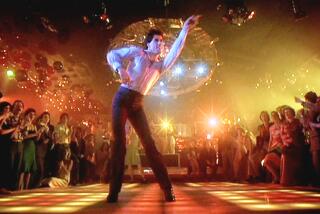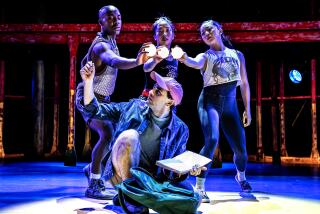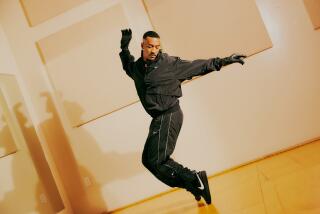How ‘White Noise’ pulled off the year’s strangest, most surprising dance number
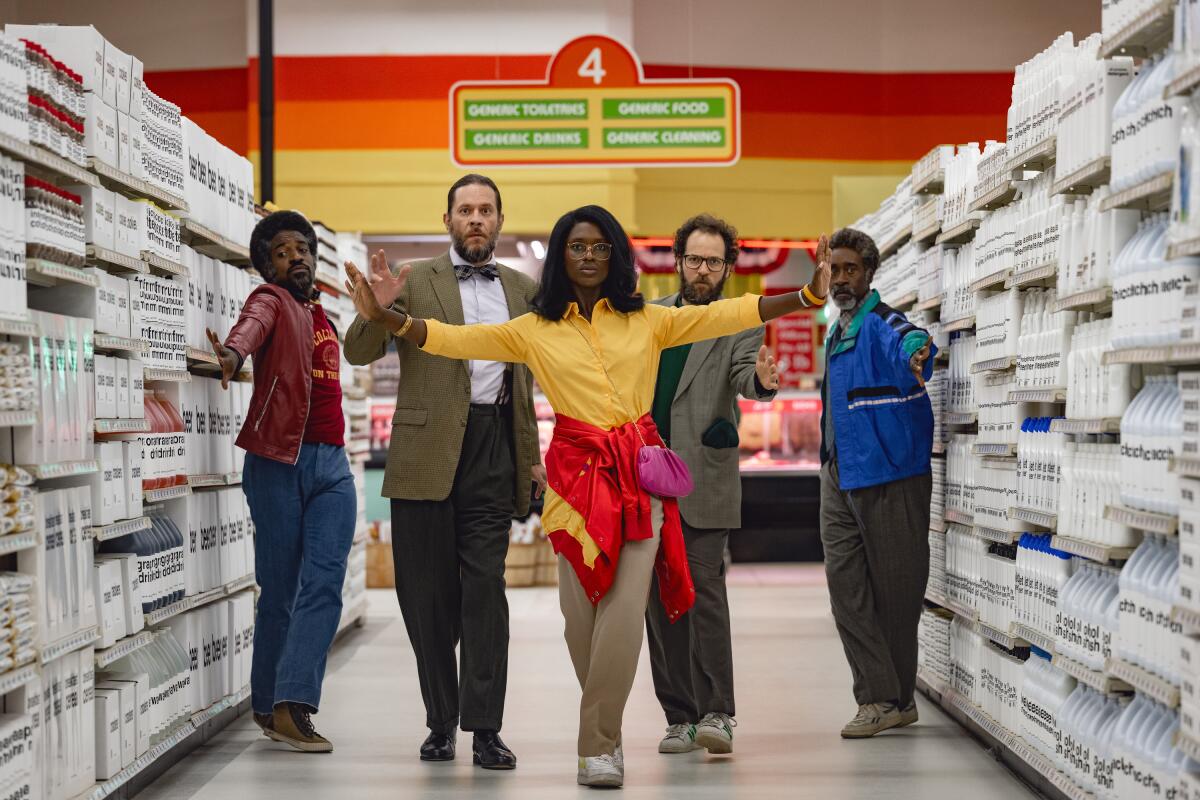
- Share via
With certain films, you’re not at all surprised to see the characters break into a joyous dance at the end: Fred Astaire and Ginger Rogers movies. Bollywood musicals. Animated films like “Shrek” or “Despicable Me.” Even the odd raucous comedy like “The 40-Year-Old Virgin.”
Then there is Noah Baumbach’s “White Noise.”
Adapted from Don DeLillo’s 1985 postmodern novel, “White Noise” — which arrives on Netflix on Friday following its theatrical run — is a darkly comic, often cerebral meditation on death. Set largely in the world of academia, the film, which stars Adam Driver and Greta Gerwig, satirizes the many ways Americans try to quiet their fear of mortality, whether through consumerism, mindless entertainment, conspiracy theories or pharmaceuticals.
In other words, not the obvious stuff of Busby Berkeley-style dance numbers.
But when Baumbach was trying to puzzle out how to end the utterly uncategorizable film, the image of an exuberant closing dance number set in the aisles of a supermarket popped into his mind. And though his previous work — intimate, often deeply personal films like “The Squid and the Whale” and “Marriage Story” — had never featured anything resembling a big, splashy dance sequence, somehow in this case it felt right.
“I suppose one way of looking at the end of book — and of the movie — is that we’re all just shopping until it’s over and we die,” Baumbach says. “So it’s a dance of life, which is also a dance of death. We like to think of them as separate but they’re not. They’re the same.”
We asked Baumbach and key members of his creative team to break down the film’s unexpected and oddly delightful end credits dance number.
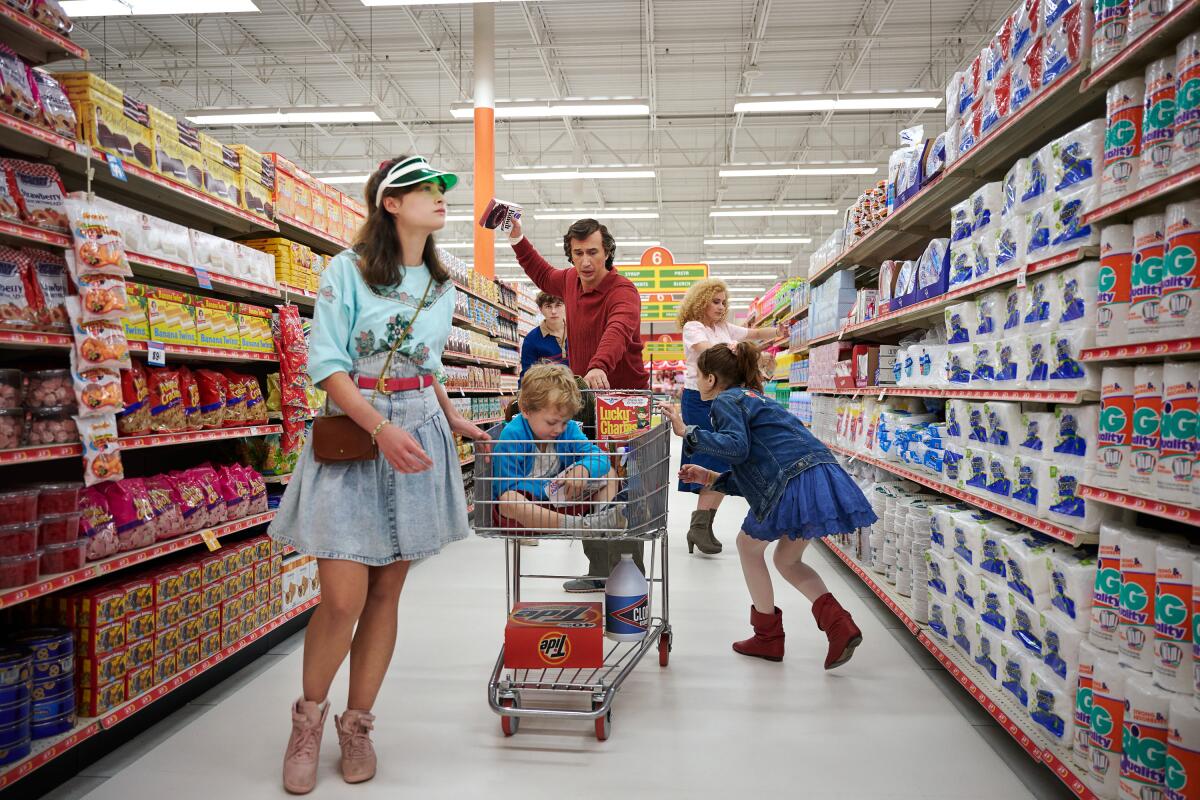
Conceiving the idea
DeLillo’s book concludes with a passage that describes shoppers walking in confused disorientation through a supermarket in which the shelves have been rearranged — a metaphor for the way we move through life, desperately clinging to the comforting routines of consumerism in an effort to keep the reality of death at bay.
“There is agitation and panic in the aisles, dismay in the faces of older shoppers,” DeLillo writes. “They walk in a fragmented trance, stop and go, clusters of well-dressed figures frozen in the aisles, trying to figure out the pattern, discern the underlying logic, trying to remember where they’d seen the Cream of Wheat.”
Mulling over that imagery, Baumbach struck on the idea of turning DeLillo’s dazed supermarket wandering into a kind of dance. In addition to offering a surprising way to end the film, a dance sequence, Baumbach realized, would provide the added benefit of making the viewer sit through the credits — a practice that has become all but lost in the era of streaming.
“I love credits,” Baumbach says. “Even when it’s not an entertaining dance number, I like to have that time to just sit with the experience at the end of a movie. I don’t want to be immediately engaging in the meaning and saying, ‘What did you think?’ I want some time to just sit with the feeling.”
Choreographing the dance
Exactly what form the closing dance sequence would take, however, was not immediately clear to Baumbach. “Initially, I was thinking, are they moving like zombies or is it more joyful?” he says. “Both are sort of true in a way.”
Working with choreographer David Neumann, Baumbach looked at ceremonial dances of death from around the world for inspiration. “We looked at many of these dances in different cultures, including some Japanese dances of death and mourning,” he says. “They were all very joyful.”
It fell to Neumann, who was nominated for a Tony Award in 2019 for his work on the musical “Hadestown,” to create a dance sequence that could capture the film’s odd tone, with its blend of deadpan comedy and existential dread, while taking full creative advantage of the supermarket setting.
As Neumann worked out the choreography, everyday movements like removing food items from the shelf, placing them in a shopping cart and scanning purchases in the checkout line formed the basis for a kind of absurdist ballet of grocery shopping.
“Noah had a sense that he wanted the dancers to be engaged in shopping but with a sense of formality,” Neumann says. “Early on, I was doing experiments with cereal boxes and various other items you can find in the supermarket in wonderment that that this was my life. I went to a lot of supermarkets with a different sense of observation, thinking, ‘What was Don DeLillo saying?’”
Creating the supermarket
Filming in Ohio, the “White Noise” production needed to create a fully functional supermarket that could be utilized not only for the final dance sequence but also for at various smaller scenes in the film. Production designer Jess Gonchor and his team ended up taking over an empty department store and converting it into a kind of idealized 1980s supermarket.
“There was nothing in there and we took about six months to stock that place, paint it, build all the shelves, the displays, the cash registers and all of that stuff,” Gonchor says. “I had to provide a space that the dancers could tell a story through, using the aisles and shopping carts, with enough room to film a beautiful sequence.”
Stocking the shelves with realistic-looking, period-appropriate items proved a painstaking task. “It was just a massive undertaking: getting products, designing labels, printing labels,” Gonchor says. “You have to take every can of Campbell’s soup, every box of Life cereal, and wrap with an old label.”
For the cast and crew, that attention to detail was a huge help. “You didn’t have to try to convince yourself that you were really in a supermarket,” says Don Cheadle, who plays a professor named Murray who studies Elvis and is a friend of Adam Driver’s Jack Gladney. “Some of the products in there were actually real — you’re like, ‘Why is this real meat?’ But the scope of it was amazing.”
“It was absolutely breathtaking to be let loose in that space,” says cinematographer Lol Crawley. “It was like this modern church of America, this temple of consumption, and we could follow [the actors] on these long sequences up and down the aisles.”
Indeed, the end result was almost too convincing. “We had people come in off the street and just grab a shopping cart and start going up and down the aisles,” Gonchor says. “We had to say, ‘No, this is not real.’ That’s the best compliment.”

Finding the music
To supply the music for the dance sequence, Baumbach turned to James Murphy of the indie rock band LCD Soundsystem, with whom he had worked on his 2010 film “Greenberg.”
“I reached out to James while we were shooting and I told him I’d like him to write an upbeat song about death,” Baumbach says. “I think there was a moment when he was worried he would never be able to figure it out, but he did.”
While waiting for the song to be completed, Neumann began rehearsing the dance with the film’s cast, supplemented by a few dozen professional dancers and additional background actors, using LCD Soundsystem’s 2005 song “Daft Punk Is Playing at My House” as a temporary track.
It was only after the dance number had been shot that Murphy delivered the finished song. Featuring jagged guitar and synthesizers, hand claps and dance-punk rhythms, “New Body Rhumba” blends references to brand names like Panasonic and Necco Wafers with more mystical-sounding lyrics about “going into the light” and “climbing down the escalator into the frigid Bardo” — a reference to the Tibetan concept of a state between death and rebirth.
The first time Neumann actually saw the sequence he had choreographed cut together with Murphy’s finished song was when “White Noise” screened in October as the opening-night selection at the New York Film Festival. “It was thrilling,” he says. “I’d like to think it captures that sense of the absurd that I loved about the novel.”
For Cheadle, it was only when he saw the finished sequence that he completely grasped what Baumbach was going for.
“With the dance itself, I don’t know that I ever fully understood what it was and why we were doing it,’ ” Cheadle says. He laughs. “But when I saw the movie, I was like, ‘Oh, I guess this makes sense.’ ”
More to Read
Only good movies
Get the Indie Focus newsletter, Mark Olsen's weekly guide to the world of cinema.
You may occasionally receive promotional content from the Los Angeles Times.
